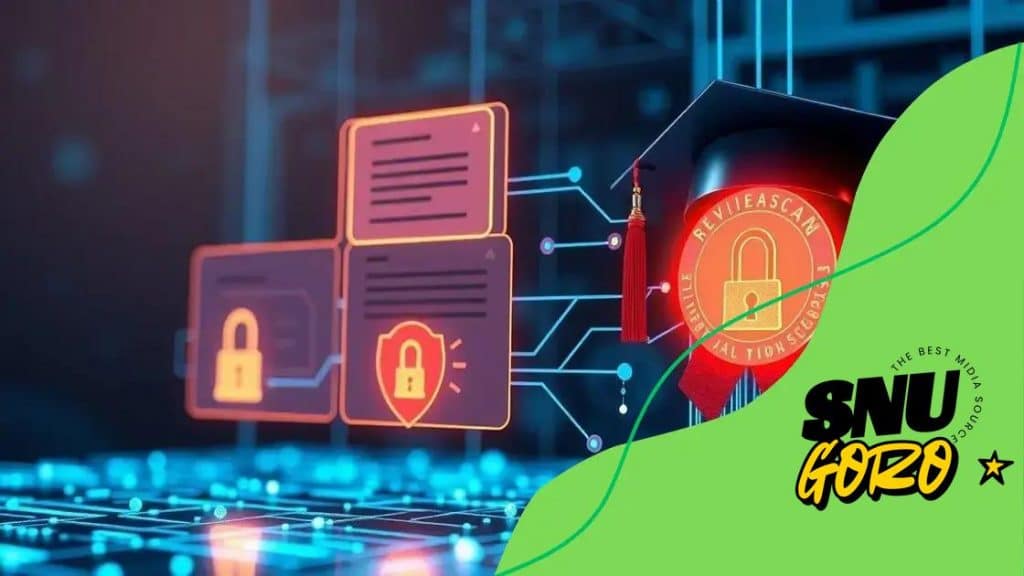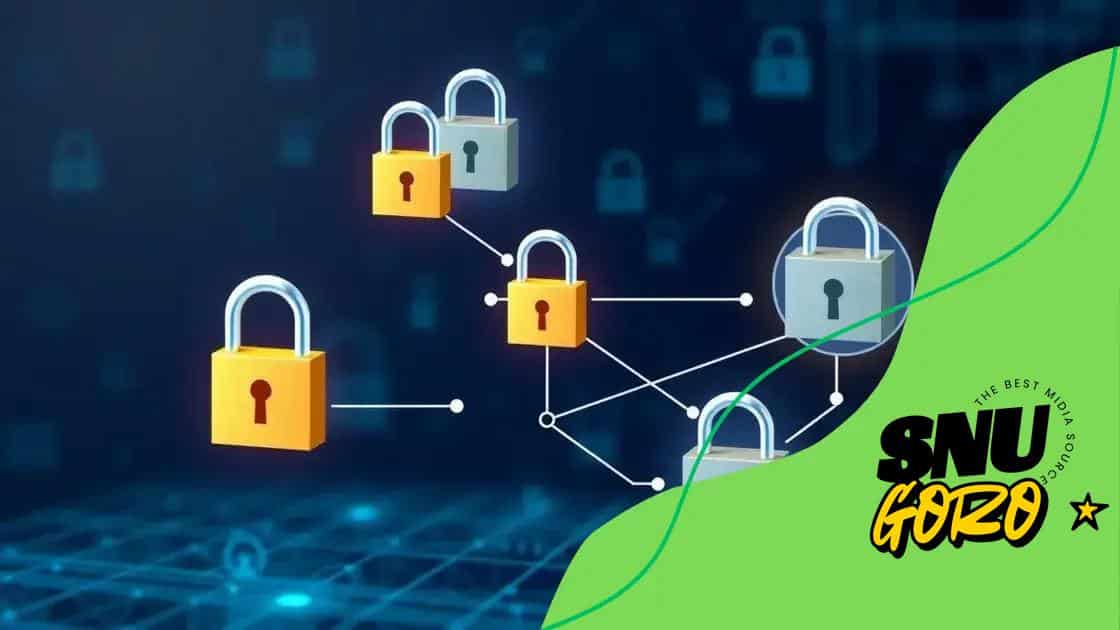Blockchain for secure diplomas and transcripts: a reliable solution

Blockchain for secure diplomas and transcripts provides a tamper-proof method to verify academic credentials, enhancing security and authenticity while allowing students to control their records.
Blockchain for secure diplomas and transcripts is transforming how we validate academic achievements. Imagine a world where your educational credentials are safe from fraud, accessible anytime, and verifiable by anyone. Curious to learn how this technology works?
Understanding blockchain technology
Understanding blockchain technology is essential to grasp how it is reshaping various industries today. This technology provides a secure, decentralized, and transparent way of handling data that has profound implications.
At its core, blockchain is a digital ledger that records transactions across many computers. This system ensures that the records cannot be altered retroactively, preserving the integrity of the data.
Key Features of Blockchain
There are several important features that make blockchain technology unique:
- Decentralization: Unlike traditional databases managed by a central authority, blockchain operates on a network of computers, eliminating single points of failure.
- Transparency: Every participant in the network has access to the entire database, promoting trust among users.
- Immutability: Once data is recorded on the blockchain, it cannot be changed, which helps prevent fraud.
- Security: Advanced cryptography protects the data, making it difficult for unauthorized users to tamper with the information.
These features make blockchain particularly suitable for applications like secure diplomas and transcripts. The educational sector can benefit immensely from this technology by ensuring that certificates issued to students are verifiable and trustworthy. When educational institutions adopt blockchain, they create a system where students can easily share their academic achievements without the fear of forgery.
In conclusion, blockchain technology’s role in providing secure and transparent methods for managing information is revolutionary. Its decentralized nature, coupled with robust security and transparency, establishes a new paradigm for handling sensitive data, particularly in education.
Benefits of using blockchain for diplomas
Understanding the benefits of using blockchain for diplomas is crucial for educational institutions and students alike. Blockchain technology helps to ensure that diplomas are secure, authentic, and easily shareable.
One major advantage is the verification process. Traditional diplomas can be forged or altered, leading to serious consequences for employers and institutions. Blockchain’s decentralized nature means that any diploma stored on the network is immediately verifiable without the need for additional layers of bureaucracy.
Key Advantages
There are several key benefits that stand out when using blockchain for diplomas:
- Enhanced Security: Blockchain’s cryptographic protocols protect data, making it very difficult for unauthorized users to alter records.
- Increased Trust: Since blockchain is transparent and immutable, both employers and universities can trust the credentials presented by candidates.
- Streamlined Processes: The traditional process of verifying diplomas can take time. Blockchain allows for instant verification, saving time for both students and employers.
- Ownership Control: Students have direct ownership of their diplomas, allowing them to easily share their credentials when necessary.
When students are able to present a verified diploma instantly, it enhances their credibility in the job market. Employers benefit from this system too, as they can verify qualifications without unnecessary delays.
Furthermore, implementing blockchain technology reduces administrative costs for educational institutions. By minimizing the chances of fraud and streamlining the verification process, both parties stand to gain significantly from this technological advancement.
Overall, the transition to using blockchain for diplomas represents a forward-thinking approach in the education sector.
How blockchain ensures security and authenticity

How blockchain ensures security and authenticity is a vital topic in today’s digital landscape. This technology offers a revolutionary approach to securing data and verifying identities.
At the heart of blockchain’s security lies its unique structure. Each block in the blockchain contains a list of transactions and is connected to the previous block, creating a chain of data that is extremely difficult to tamper with. This linkage is achieved through complex cryptographic hashes.
Critical Security Features
Several features of blockchain technology contribute to its robust security:
- Decentralization: Unlike traditional databases that rely on a central authority, blockchain is stored across a network of computers. This reduces the risk of a single point of failure.
- Immutability: Once data is added to the blockchain, it cannot be altered or deleted without consensus from the network. This ensures that records remain accurate over time.
- Transparency: Every transaction on the blockchain is visible to participants in the network. This level of openness helps to build trust among users.
- Cryptographic Security: Each transaction is secured using encryption, protecting it from unauthorized access.
These features work together to make blockchain a powerful tool for ensuring authenticity. For instance, when a diploma is issued on the blockchain, it can be securely shared and verified by employers. They can easily confirm that the diploma is genuine, without the need for time-consuming background checks.
Furthermore, each user in the blockchain network has a unique cryptographic key that secures their data and ensures that only authorized individuals can interact with their records. This personal control enhances security and keeps sensitive information safe from unauthorized access.
Consequently, organizations that adopt blockchain technology not only improve their data security but also create an ecosystem where trust and authenticity thrive.
Case studies of blockchain in education
Examining case studies of blockchain in education reveals how this technology is being implemented to address common challenges in academic institutions. Several universities and organizations are pioneering its use to enhance the credibility and security of educational credentials.
One notable example is the University of Malta, which has integrated blockchain technology into its educational system. They issue diplomas on a blockchain platform. This allows graduates to easily share their credentials, ensuring that potential employers can verify their authenticity in real time.
Real-World Examples
Another prominent case is that of New Jersey Institute of Technology (NJIT). They partnered with a blockchain company to record degree confirmations. This initiative enhances the trust employers have in the qualifications of job applicants, significantly reducing the time and resources spent on verifying educational backgrounds.
- MIT Media Lab: MIT uses blockchain technology to issue certificates for completed courses. These digital certificates can be shared directly from a secure blockchain ledger, making the verification process seamless.
- Learning Machine: This organization has developed a platform that allows institutions to issue blockchain-based credentials. Their model emphasizes ownership and privacy, enabling students to control their own data.
- Wollongong University: In Australia, Wollongong University has also adopted blockchain technology to provide a secure way of issuing diplomas. This gives students a reliable method to share their accomplishments instantly.
These case studies demonstrate the diverse applications of blockchain in the educational sector. Institutions are not only improving security but also increasing transparency and efficiency. By offering verified credentials on a blockchain, universities contribute to a more trustworthy educational landscape.
As more educational institutions embrace this technology, the potential benefits will continue to grow, paving the way for enhanced student experiences and organizational credibility.
Future trends in blockchain for transcripts
Exploring future trends in blockchain for transcripts reveals exciting possibilities that could reshape how academic achievements are recorded and shared. With the rapid advancements in blockchain technology, the educational landscape is on the verge of significant changes.
One major trend is the increasing adoption of blockchain by educational institutions worldwide. As more universities recognize the benefits of providing secure and verifiable transcripts on the blockchain, we can expect widespread implementation in the coming years. This will allow students to maintain complete control over their academic records, granting them the ability to share their achievements with employers and other educational institutions securely.
Innovative Applications
Another trend is the integration of blockchain with other emerging technologies. For instance, combining blockchain with artificial intelligence (AI) can enhance the verification process. AI algorithms may analyze data from blockchain records, improving the efficiency of credential verification while maintaining security.
- Interoperability: Future systems may focus on creating interoperable blockchain networks, allowing different institutions to share records seamlessly while maintaining security and privacy.
- Smart Contracts: The use of smart contracts in blockchain can automate processes like issuing transcripts, reducing administrative workloads and potential for errors.
- Digital Identity Management: Blockchain could provide a secure framework for managing digital identities. This could streamline the application process for students, making it easier and faster to verify their credentials.
Furthermore, as more employers seek to validate educational backgrounds, the importance of blockchain will grow. It allows organizations to access accurate information almost in real-time, reducing hiring risks associated with fraudulent credentials.
Educational institutions may also collaborate internationally, utilizing blockchain as a global standard for transcripts. This can facilitate student mobility, as students can effortlessly transfer their academic records between institutions in different countries.
FAQ – Frequently Asked Questions about Blockchain for Secure Diplomas and Transcripts
What is blockchain technology and how does it work?
Blockchain technology is a decentralized digital ledger that securely records transactions across multiple computers. It ensures that the data is transparent and cannot be altered without consensus.
How does blockchain enhance the security of academic credentials?
Blockchain enhances security by creating immutable records that are encrypted and decentralized, making it difficult for anyone to forge or alter academic credentials.
Can blockchain benefit both students and educational institutions?
Yes, blockchain benefits students by providing verifiable credentials and helps institutions by streamlining verification processes and reducing fraud.
What future trends can we expect in blockchain for education?
Future trends include greater adoption by educational institutions, integration with AI for enhanced verification, and the development of interoperable systems for seamless record sharing.





